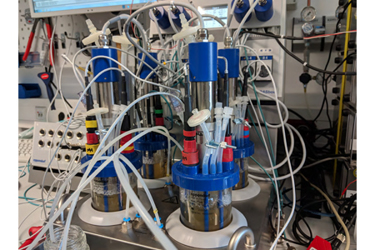Anaerobic Clostridium Beijerinckii Fermentation In Small- Scale Bioreactor Control Systems
By Ying Yang, Robert Glaser, Nina Schrand, and Ma Sha

To demonstrate the feasibility of conducting anaerobic fermentation in Eppendorf small scale fermenters, we grew the obligate anaerobe Clostridium beijerinckii, a natural producer of butanol and isopropanol, in BioBLU® f Single-Use Vessels controlled by the DASbox® Mini Bioreactor and DASGIP® Parallel Bioreactor Systems. The regeneration of the NAD(P)+ pool in Clostridium species is essential for the direction of the electron flow towards the final product butanol. Moreover, the intracellular ratio of the electron donor pair NAD(P)+/NAD(P)H is related to the redox potential. Therefore, it is important to monitor and control redox potential during Clostridium fermentation to track and adjust the physiological status of the anaerobes.
The objectives of this study are (1) to demonstrate the feasibility of running anaerobic fermentation under these two control stations for small scale applications; (2) to show the importance of redox potential monitoring and control in C. beijerinckii fermentation and how it affects bacterial growth and solvent production; and (3) to provide a scale-up example of anaerobic fermentation using BioBLU f Single-Use Vessels which are capable of strictly holding oxygen-free conditions. We found comparable growth and butanol production in the two scales tested based on the constant tip speed scale-up principle, and the increased butanol and isopropanol production when redox potential was appropriately controlled.
Get unlimited access to:
Enter your credentials below to log in. Not yet a member of Bioprocess Online? Subscribe today.
